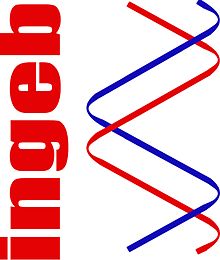
The Bosna is the third longest river in Bosnia and Herzegovina, and is considered one of the country's three major internal rivers, along with the Neretva and the Vrbas. The other three major rivers of Bosnia and Herzegovina are the Una, to the northwest; the Sava, to the north, and the Drina, to the east. This river is the namesake of Bosnia. The river Bosna flows for 282 kilometers (175 mi).
A polygene is a member of a group of non-epistatic genes that interact additively to influence a phenotypic trait, thus contributing to multiple-gene inheritance, a type of non-Mendelian inheritance, as opposed to single-gene inheritance, which is the core notion of Mendelian inheritance. The term "monozygous" is usually used to refer to a hypothetical gene as it is often difficult to distinguish the effect of an individual gene from the effects of other genes and the environment on a particular phenotype. Advances in statistical methodology and high throughput sequencing are, however, allowing researchers to locate candidate genes for the trait. In the case that such a gene is identified, it is referred to as a quantitative trait locus (QTL). These genes are generally pleiotropic as well. The genes that contribute to type 2 diabetes are thought to be mostly polygenes. In July 2016, scientists reported identifying a set of 355 genes from the last universal common ancestor (LUCA) of all organisms living on Earth.

Kotor Varoš is a town and municipality located in north-western Republika Srpska, an entity of Bosnia and Herzegovina. As of 2013 census, it has a population of 19,710 inhabitants, while the town of Kotor Varoš has a population of 7,330 inhabitants.

The University of Sarajevo is a public university located in Sarajevo, Bosnia and Herzegovina. It is the largest and oldest university in the country, tracing its initial origins to 1537 as an Islamic madrasa.

The Sarajevo Music Academy or Music Academy | University of Sarajevo is a Faculty of Music of University of Sarajevo in Bosnia and Herzegovina.
Šiprage is a settlement municipality in the Bosnia and Herzegovina, Republika Srpska entity, Kotor Varoš Municipality.
The Crkvenica is a Bosnian river. It is a right bank tributary of the Vrbanja River.

Acceleration in human development process is the phenomenon which has been registered in many populations around the world. This applies equally to the growth of certain anthropometric parameters and the speed of reaching sexual maturity. These facts illustrate the results of secular changes in body height and appearance of the first menstruation (menarche).
Academician Rifat Hadžiselimović is a Bosnian geneticist. He was born in Šiprage, Bosnia and Herzegovina on 7 January 1944. In 2013, with over 45 years of service, he was appointed Emeritus. He acts as scientific adviser in Institute for Genetic Engineering and Biotechnology, University of Sarajevo.

Unsuccessful transfer or abortive transfer is any bacterial DNA transfer from donor cells to recipient cells that fails to survive transduction and conjugation. In all cases, the transferred fragment could be diluted during the proliferation phase. Failures in the integration of the transferred DNA in the genetic material of the recipient cells may be due to:
Annulate lamella is one of the cell membrane classes, occurring as a set of parallel elements with double-walled membranes in the same plane/dimension, just as the nuclear envelope. These lamella have pore complexes which are identical to those of the nuclear envelope. It is arranged in highly ordered structure with a regular spacing between themselves.
Salmedin Mesihović is a Bosnian professor of history and archaeology at the Faculty of Philosophy, Department of History, at University of Sarajevo, Bosnia and Herzegovina.

The Academy of Fine Arts Sarajevo is a faculty within the University of Sarajevo in Sarajevo, Bosnia and Herzegovina, dedicated to the fine arts.
Pejo Ćošković, born on 12 April 1952 in Domaljevac near Bosanski Šamac, is Bosnian medievalist and lecturer at the Faculty of Philosophy of the University of Sarajevo, Department of History, in Sarajevo, Bosnia and Herzegovina.
Husnija Kamberović is a Bosnian historian and a professor of modern history at the Faculty of Philosophy, University of Sarajevo, in Sarajevo, Bosnia and Herzegovina.

Ivan Lovrenović is a Bosnia and Herzegovina publicist, writer, historian, essayist, and editor.
Vladimir Boberić (secular name: Vladislav Boberić, Srpska Klarija was the bishop of the Serbian Orthodox Church and professor of music.
The somatic mutation and recombination tests (SMARTs) are in vivo genotoxicity tests performed in Drosophila melanogaster. These fruit fly tests are a short-term test and a non-mammalian approach for in vivo testing of putative genotoxins found in the environment. D. melanogaster has a short lifespan, which allows for fast reproductive cycles and high-throughput genotoxicity testing. D. melanogaster also has around 75% functional orthologs of human disease-related genes, making it an attractive in vivo model for human research. The tests identify loss of heterozygosity for the specified genetic markers in heterozygous or trans-heterozygous adults using phenotypically observable genetic markers in adult tissues. Although diverse events like point mutations/deletions, nondisjunction, and homologous mitotic recombination might theoretically cause this loss of heterozygozity, nondisjunction processes are generally not relevant for most of the examined chemicals. SMARTs are two different tests that use the same genetic foundation, but target different adult tissues and are named accordingly: the wing-spot test and the eye-spot test.
The Center for Demographic Genetics of the Academy of Sciences and Arts of Bosnia and Herzegovina, was established on July 15, 2020 at the formal proposal of the Department of Natural and Mathematical Sciences, which was represented by a wider circle of interested institutions and individuals in the field of natural and social sciences.

Boris Nilević was a Bosnian historian of the middle-ages and early modern era.










